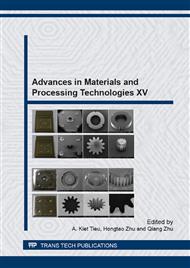[1]
N.N, Market Analysis for Microsystems 1996–2002, NEXUS Task.
Google Scholar
[2]
F. Vollertsen, Z.Y. Hu, H. S. Niehoff, C. Theiler, State of the art in micro forming and investigations into micro deep drawing, Journal of Materials Processing Technology 151 (2004) 70-79.
DOI: 10.1016/j.jmatprotec.2004.04.266
Google Scholar
[3]
M. Geiger, M. Kleiner, R. Eckstein, N. Tiesler, U. Engel, Microforming. 51st General Assembly of CIRP, Nancy 50 (2) (2001) 445-462.
DOI: 10.1016/s0007-8506(07)62991-6
Google Scholar
[4]
Y. Qin, Micro-forming and miniature manufacturing systems - development needs and perspectives, Journal of Materials Processing Technology 177 (2006) 8-18.
DOI: 10.1016/j.jmatprotec.2006.03.212
Google Scholar
[5]
D.E. Brehl, T.A. Dow, Review of vibration-assisted machining, Precision Engineering 32 (2008) 153-172.
DOI: 10.1016/j.precisioneng.2007.08.003
Google Scholar
[6]
S. S. F. Chang, G. M. Bone, Thrust force model for vibration-assisted drilling of aluminum 6061-T6, International Journal of Machine Tools & Manufacture 49 (2009) 1070-1076.
DOI: 10.1016/j.ijmachtools.2009.07.011
Google Scholar
[7]
Y. Bai, K. Nishikawa, M. Yang, Metal Surface Modification with Vibration-Aided Micro-Forging, Materials Transactions 53 (2012) 489-494.
DOI: 10.2320/matertrans.m2011254
Google Scholar
[8]
M. Pau, Estimation of real contact area in a wheel-rail system by means of ultrasonic waves, Tribology International 36 (2003) 687-690.
DOI: 10.1016/s0301-679x(03)00014-8
Google Scholar
[9]
I. Nitta, Measurements of real contact areas using PET films (thickness, 0.9 μm), Wear 181-183 (1995) 844-849.
DOI: 10.1016/0043-1648(94)07091-1
Google Scholar
[10]
M. Eguchi, T. Shibamiya, T. Yamamoto, Measurement of real contact area and analysis of stick/slip region, Tribology International 42 (2009) 1781-1791.
DOI: 10.1016/j.triboint.2009.04.046
Google Scholar
[11]
B. Buchner, M. Buchner, B. Buchmayr, Determination of the real contact area for numerical simulation, Tribology International 42 (2009) 897-901.
DOI: 10.1016/j.triboint.2008.12.009
Google Scholar


